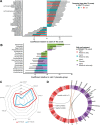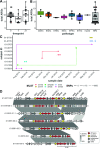Gut microbiome and antibiotic resistance effects during travelers' diarrhea treatment and prevention
- PMID: 38085102
- PMCID: PMC10790752
- DOI: 10.1128/mbio.02790-23
Gut microbiome and antibiotic resistance effects during travelers' diarrhea treatment and prevention
Abstract
The travelers' gut microbiome is potentially assaulted by acute and chronic perturbations (e.g., diarrhea, antibiotic use, and different environments). Prior studies of the impact of travel and travelers' diarrhea (TD) on the microbiome have not directly compared antibiotic regimens, and studies of different antibiotic regimens have not considered travelers' microbiomes. This gap is important to be addressed as the use of antibiotics to treat or prevent TD-even in moderate to severe cases or in regions with high infectious disease burden-is controversial based on the concerns for unintended consequences to the gut microbiome and antimicrobial resistance (AMR) emergence. Our study addresses this by evaluating the impact of defined antibiotic regimens (single-dose treatment or daily prophylaxis) on the gut microbiome and resistomes of deployed servicemembers, using samples collected during clinical trials. Our findings indicate that the antibiotic treatment regimens that were studied generally do not lead to adverse effects on the gut microbiome and resistome and identify the relative risks associated with prophylaxis. These results can be used to inform therapeutic guidelines for the prevention and treatment of TD and make progress toward using microbiome information in personalized medical care.
Keywords: antibiotic resistance; human microbiome; international travel; travelers' diarrhea.
Conflict of interest statement
The authors declare no conflict of interest.
Figures





References
-
- Putnam SD, Sanders JW, Frenck RW, Monteville M, Riddle MS, Rockabrand DM, Sharp TW, Frankart C, Tribble DR. 2006. Self-reported description of diarrhea among military populations in operations Iraqi freedom and enduring freedom. J Travel Med 13:92–99. doi: 10.1111/j.1708-8305.2006.00020.x - DOI - PubMed
MeSH terms
Substances
Grants and funding
LinkOut - more resources
Full Text Sources
Medical
Miscellaneous
